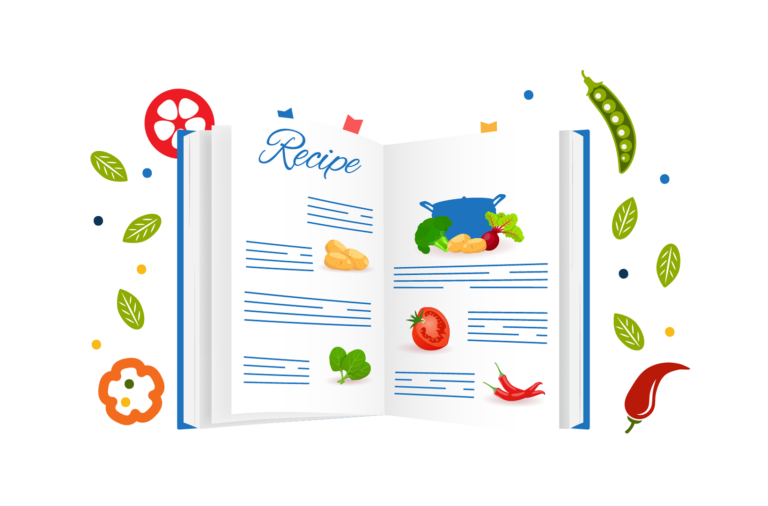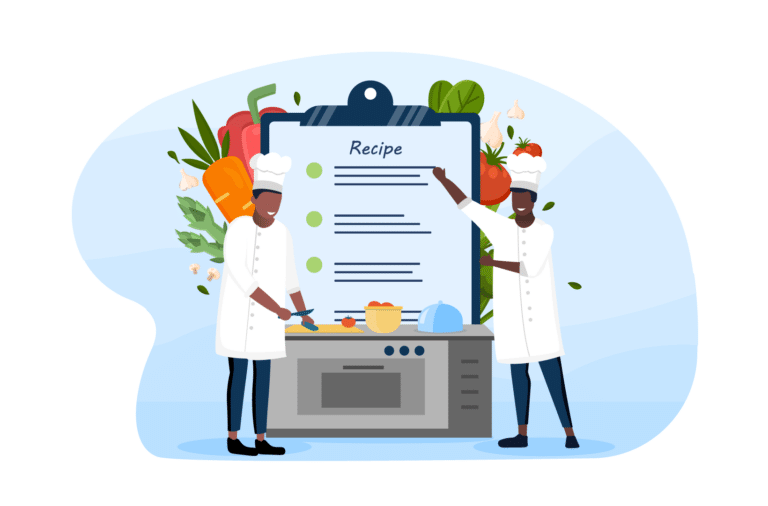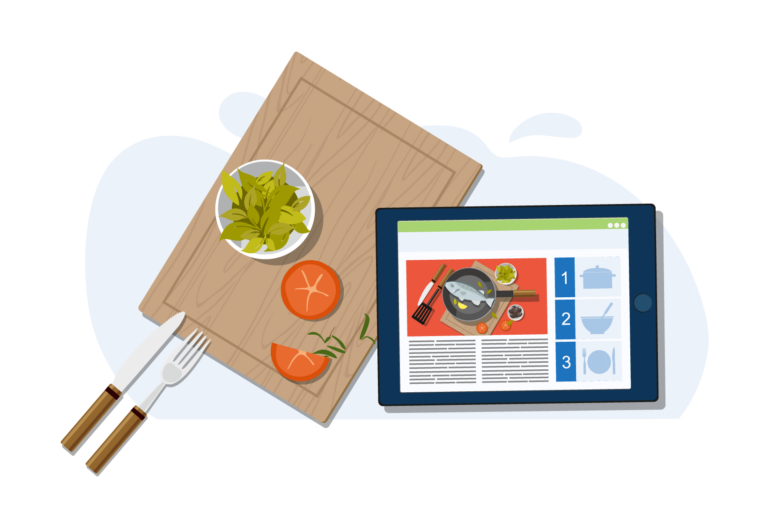There are some misconceptions surrounding recipe copyright. Some people believe that recipes can’t be copyrighted at all or that just changing one or two details may be enough. However, the truth is that there are some ways recipes can be copyrighted and some ways they can’t.
The way a recipe is presented as a creative work, such as the narrative description, layout, and photos, can all fall under copyright law. However, the basics of the recipe itself, such as the ingredient list or basic cooking methods, can’t be copyrighted.
Recipe copyright can be complicated, especially in a world where creating and posting recipes and cookbooks online is so simple. Infringement, accidental or on purpose, is more common than you might think. Although recipes have elements that can’t be copyrighted, there are steps you can take to ensure your work isn’t used without proper attribution. This guide will outline how you can protect your recipes online.
The complex world of recipe copyright and fair use
Copyright is a legal system that protects intellectual property, ranging from literature and music to art and more. It’s important to consider copyright law in regard to recipes because written recipes are original works. Some parts of a recipe can be copyrighted, while others are not original enough to come under copyright law.
Recipes are often not protected by copyright laws. Put simply, this is because recipes are considered ideas – describing a process or combination of ingredients – that are not copyrightable. Copyright protection for ideas could potentially stifle creativity by preventing others from building upon or reinterpreting those ideas in new and transformative ways. What’s more, determining the originality and ownership of ideas can be difficult.
However, while the recipe itself can not be copyrighted, the creative aspect of a written and published recipe is typically protected by copyright. This includes narrative text and photographs or other images. A recipe consisting of an ingredient list and basic instructions is unlikely to be copyrightable, whereas one with a thorough and detailed explanation is more likely to be protected.
Another factor to consider is “fair use”. This concept allows people to use and share some original works or parts of original works without breaking copyright law.
The four factors that define fair use are:
- Purpose and character of the use.
- The nature of the copyrighted work.
- The amount and substantiality of the portion taken.
- The effect of the use on the potential market.
In relation to recipes, fair use will typically allow people to comment on, critique, review, and report on recipes.
Common myths about copyrighting recipes
The most commonly believed myth about recipe copyright is that changing a few ingredients makes it an original recipe. However, simply altering a few ingredients in an existing recipe doesn’t make it original. Therefore, it’s important to note that making minor tweaks to an existing recipe is not enough. Some other common misconceptions about recipe copyright include:
- If it’s on the internet, it’s free to use.
- Recipes older than 100 years are public domain.
- Recipes from cookbooks are fair game.
Trademark, patent, or trade secret: Which works best?
Copyright is just one type of intellectual property (IP) that allows people to protect their creations. IP rights can be used to help protect recipes in different ways, with several options available. Three key possibilities are trademarking, patenting, and trade secrets.
Trademark
A trademark can protect your branding, including your brand name and design elements. A restaurant might use it to protect its distinctive decor, tagline, or logo. However, trademarking can’t be used to protect recipes. It’s rarely used for recipe names or other elements, although it can be used to trademark distinctive decor, phrases, and the names of dishes. For example, McDonald’s has trademarked its iconic Big Mac name.
As well as protecting themselves by using a trademark, a strong brand identity can deter potential infringers and indirectly protect a recipe by safeguarding the associated branding. It also makes it easier to prove copyright infringement if it occurs.
Patent
A patent applies to inventions. It is used to protect the inventor’s exclusive right to use and sell their invention when they file a patent with the patent office. The process of applying for a patent can be complicated, and it’s not guaranteed they will be granted. For a recipe to qualify for a patent, it needs to be novel and non-obvious to a skilled cook. For example, suppose a recipe involves a unique method of preserving food, creating a new texture or flavor, or using an innovative combination of ingredients. In that case, it might be eligible for patent protection.
However, it’s important to note that patenting a recipe is a rare and often impractical route for many food creators. The process can be costly and time-consuming, making it inaccessible for most, especially if you’re just starting out in food blogging. Additionally, even if a recipe is patented, the protection only lasts for a limited time, generally 20 years from the date of filing the patent application. After this, the recipe becomes general knowledge and accessible to the public.
Trade secret
A trade secret might be used to protect the ingredients or methods in a recipe. Some famous examples include Coca-Cola’s recipe and KFC’s famous ‘11 herbs and spices’ mix. There isn’t a formal legal procedure for creating a trade secret. Instead, this type of protection works through people agreeing to sign non-disclosure agreements (NDAs) that prevent them from sharing relevant information with people outside of the business.
In theory, a trade secret could easily be stolen. Even if everyone follows their NDAs, they can expire, so the signee is eventually allowed to share the information. However, there could be serious legal consequences for anyone who breaks the agreement and shares confidential information.
Strategies to safeguard your recipes from theft
If you want to protect your recipes from theft, there are multiple strategies you can use.
- Go beyond the basic ingredients list and method. You can also include photos and videos, which can be copyrighted. For extra protection, include a small watermark on your images.
- Personalize your food blog writing with more descriptive details that are more likely to be protected by copyright. This will prevent people from copying and pasting your recipe and require them to completely rewrite it to avoid copyright infringement.
- Include a link to your email, encouraging readers to email you for permission to reproduce your recipe. This demonstrates that it can’t just be copied.
- When adapting other people’s recipes, ensure you give proper attribution to the recipe writers. This is good practice and sets an example for your readers to do the same.
Best practices for correctly attributing a recipe’s origin
Giving fair attribution to other recipe authors is essential to help maintain integrity and respect in the culinary community. If you adapt a recipe from another source or take inspiration from it, don’t forget to provide a link or reference. If you don’t do this, you could find someone making a copyright claim against you. Although heavily modified recipes often count as new recipes, it’s still best practice to credit the original source.
Action steps if your recipe has been infringed upon
Suspecting that someone has infringed upon your copyright by using your recipe without proper attribution can be worrying. However, there are some clear steps you can take to address the issue.
Step 1: Identify the infringement
Firstly, confirm that someone has taken your content without permission. You might observe that someone is using your photos, has copied unique elements of the recipe, or hasn’t given you proper credit.
Step 2: Document the infringement
If you want to address a copyright infringement, you should gather evidence. One easy step is to get screenshots. Save a link to the page where the copied recipe is and consider using Archive.org to look for captures of the live page.
Step 3: Legal recourse options
There are a few ways you might try to get a copied recipe removed. Common options include sending a cease and desist letter or using a Digital Millennium Copyright Act (DMCA) takedown notice. Before taking either route, it’s best to seek professional legal advice.
How to share recipes confidently as a food blogger
When creating new recipes is your passion, a food blog or recipe website allows you to share them with the world. When you understand the ins and outs of sharing online without tripping over recipe copyright issues, you can do it with confidence.
WordPress is the most popular content management system for bloggers. It’s very user-friendly, with a great range of plugins to add functionality without the need for coding skills. If you are going to use WordPress for your food blog, then WP Recipe Maker is an essential tool. It gives you all the functionality you need to display recipes, which you don’t get by default. What’s more, the plugin is designed especially for food bloggers and is extremely easy to use, even if you’re just starting out.
Recipe visibility
WP Recipe Maker is SEO-friendly, enabling you to grow the visibility of your blog in search engines. The built-in SEO functionality automatically adds your meta description, making it easier for your recipe pages to rank and therefore establishing your recipes as a primary source on the web. In turn, this will deter theft by establishing original content by ranking higher in search results.

Stylized recipe cards
Another great feature is that it gives you the tools you need to create highly branded and stylized recipe cards. You can easily change colors, text, and icons to completely change the look to suit your personal brand identity. Plus, with the option to add author links, identity and attribution are easier to manage.

Bespoke photography
Including photos, videos, and descriptive text will help ensure your recipe is covered by copyright law. WP Recipe Maker is the ideal plugin to help you manage all of this. You can easily include additional elements, such as bespoke images and videos, with your recipes using the plugin’s easy-to-use features. In addition to being able to add a main recipe image, you can also add images of ingredients and equipment. Plus, it’s possible to place videos anywhere on the page to customize any food blog. By mastering the art of food photography, you can add real value to your recipes.
Jump-to-recipe
The jump-to-recipe feature allows you to include all of this additional material, including descriptions and a backstory of how you came up with the recipe, while still giving readers the option to skip straight to the main recipe if that’s what they prefer.

“Ensuring your online recipes have clear attribution signals – like proper names, image copyrights, and detailed information – acts as a vital safeguard for food bloggers. This practical step not only protects your hard work but also establishes a unique online presence, ensuring you get the credit you deserve in a digital world where recipe theft is a real concern.”
Birthe VandermeerenCofounder of Bootstrapped Ventures

Take the next step: Protecting your online recipes
Copyrighting recipes can be difficult, especially as some things can be copyrighted and some can’t. However, if you take the time to enhance your recipes and go beyond the basics, you can feel confident that they’re protected. Basic ingredient lists and instructions won’t be protected by copyright law, so it’s important to go beyond this. Personalize your writing and include photos and videos to accompany your branded recipe cards on WP Recipe Maker.
Assigning yourself as the creator, adding the correct recipe authors, and even giving credit to others is simple when formatting your recipes using WP Recipe Maker. As a food blogger, you want to be confident about asserting your rights and using available recourse to protect your recipes. Although copyright on the internet can be complicated, there are still tools and rules in place to allow you to protect your intellectual property.
Enhance your food blog with WP Recipe Maker so you can add more copyrightable elements to your recipes.







